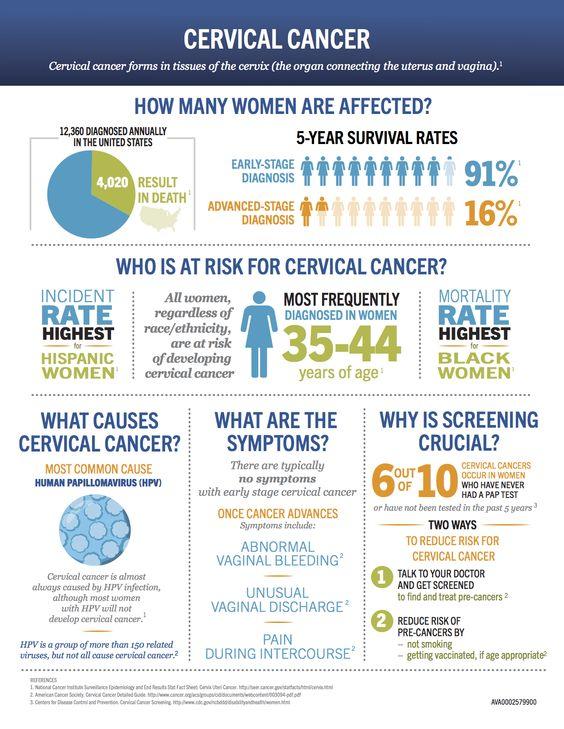What is cervical cancer?
Cervical cancer is the cancer of the cervix (the lower part of the uterus that opens into the vagina. This cancer is caused by a virus known as human papillomavirus (HPV). The HPV virus is found both in men and women and is spread mostly by sexual contact.
Most people are infected with HPV virus at some point or other in their lives. This virus is so common that almost all sexually active people will have it on their genital skin. Most of the times the HPV infection does not have any symptoms and most of the people are unaware of the infection. The body usually itself clears the virus naturally within two years. However, the problem starts when the body is not able to clear the HPV virus.

Everything You Need to Know about Cervical Cancer from Treatment to Recovery
Learn More
This can lead to changes in the cells of the cervix, which can develop into cervical cancer. It normally takes about 10 to 15 years for an HPV infection to develop into cervical cancer. It is important to keep in mind the symptoms of cervical cancer as the early cervical cancer symptoms are often confused with the premenstrual symptoms. Some symptoms of cervical cancer include:
- Irregular vaginal bleeding
- Abnormal vaginal discharge
- Pain in the lower belly or pelvis
- Pain during sexual activity
Fatigue, pain in legs and back, weight loss, and bone fractures usually indicate stage 3 of cervical cancer.
Prevention of Cervical Cancer

You can reduce the risk of an HPV infection turning into cervical cancer by following the below steps:
- Use condoms. They might not fully protect from HPV infection but reduce the risk as well as protect against sexually transmitted diseases (STDs).
- Stay active, eat well, exercise regularly, maintain a healthy body weight, and manage stress levels.
- Do not smoke. Tobacco can lead to a weakened immune system, which makes it difficult for the body to fight infection.
- Undergo HPV vaccination. It is best to get vaccinated before becoming sexually active. However, sexually active women can also get this vaccination.
- Undergo regular screening for cervical cancer after 25 years of age.

Check out Top Hospitals for Cervical Cancer Treatment
Explore
Cervical cancer can be prevented by regular cervical screening. Screening can help detect HPV infection before it develops into cervical cancer. Detection of HPV infection at an early stage can allow your healthcare professional to monitor the infection and intervene in case of a change in cells of your cervix.
When to undergo cervical cancer screening?
It is recommended that if you are between 25 to 74 years of age and are sexually active, you should undergo cervical screening every 3 years. This includes women who have:
- Stopped having sex
- A partial hysterectomy and still have a cervix
- Identified themselves as lesbian or transgender
- Felt healthy and have no symptoms
- Had only one sexual partner
- Had menopause
- A cervix and are sexually active
Different Types of Cervical Screening Tests
1. Pap Test
The Pap test, also known as a smear test, is the most common screening exam for cervical cancer. During this test, a healthcare professional collects a sample of cells from the cervix, which is looked under a microscope to detect any abnormal changes. A Pap test does not test for any other cancers in the reproductive organs such as ovarian cancer or other STDs.
2. HPV Test
The HPV test is done by removing a sample of cells from a woman’s cervix. This sample is then tested for the strains of HPV most likely linked with cervical cancer. HPV test can be combined with Pap test.
In order to undergo a cervical cancer screening test, try to make an appointment on a day when you don’t have your periods. Do not use tampons, medicines or creams in your vagina and do not have sex 48 hours before the test.
Follow up of an abnormal Pap or HPV test is important because it can help prevent cervical cancer. In case a Pap test or HPV test show abnormal changes in the cervix, then follow-up tests need to be done. These may include e the following:
3. Colposcopy
A specialist looks through a magnifying lens (colposcope) to examine your cervix more closely and in greater detail. You will be asked to lie in a manner similar to Pap test and then, an instrument called a speculum will be inserted into your vagina, to allow the cervix to be clearly seen.
A liquid is applied to the cervix to highlight any abnormal areas. The colposcopy itself does not enter the body. The whole process takes about 15 minutes and most people do not experience any pain. Ask your doctor or specialist any doubts or questions you might have about this test such as what does it mean if something is found during this examination.
4. Coloscopic biopsy
If areas of your cervix appear to be abnormal during a colposcopy test, the specialist may take a small sample of tissue from your cervix for testing. This is known as a biopsy.
5. Endo-cervical curettage
A procedure where the mucus membrane of the cervical canal is scraped using a spoon like an instrument known as curettage in order to detect abnormal, precancerous conditions or cervical cancer.
6. Endometrial curettage
This procedure involves dilation of the uterine cervix so as to remove the lining of the uterus by scraping or suction. It is also used to detect cervical cancer.
In order to treat the abnormalities of the cervix found in the above test, a woman may need to undergo:
7. Cone biopsy
A minor operation where a cone-shaped part of cervix containing the abnormal cells is removed.
8. Cryosurgery
A surgery where extreme cold is used to destroy the abnormal cells.
9. Laser surgery
This involves removal of abnormal cells using heat generated from a laser beam.
10. Hysterectomy
Complete hysterectomy means removal of the uterus and cervix.
After any kind of treatment, it is important not to use tampons, swim, or have vaginal intercourse for 3 to 4 weeks until the healing of the cervix. Vigorous exercises should also be avoided for a week in order to prevent bleeding or infection.

Looking for a Treatment Plan for Cervical Cancer?
Get the Best Quote



